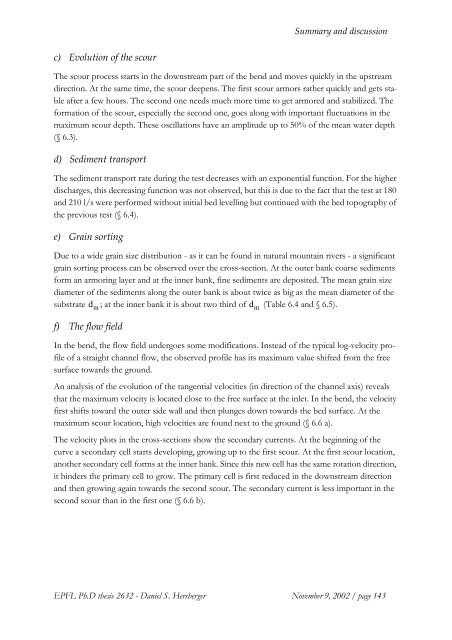pdf, 12 MiB - Infoscience - EPFL
pdf, 12 MiB - Infoscience - EPFL
pdf, 12 MiB - Infoscience - EPFL
You also want an ePaper? Increase the reach of your titles
YUMPU automatically turns print PDFs into web optimized ePapers that Google loves.
Summary and discussion<br />
c) Evolution of the scour<br />
The scour process starts in the downstream part of the bend and moves quickly in the upstream<br />
direction. At the same time, the scour deepens. The first scour armors rather quickly and gets stable<br />
after a few hours. The second one needs much more time to get armored and stabilized. The<br />
formation of the scour, especially the second one, goes along with important fluctuations in the<br />
maximum scour depth. These oscillations have an amplitude up to 50% of the mean water depth<br />
(§ 6.3).<br />
d) Sediment transport<br />
The sediment transport rate during the test decreases with an exponential function. For the higher<br />
discharges, this decreasing function was not observed, but this is due to the fact that the test at 180<br />
and 210 l/s were performed without initial bed levelling but continued with the bed topography of<br />
the previous test (§ 6.4).<br />
e) Grain sorting<br />
Due to a wide grain size distribution - as it can be found in natural mountain rivers - a significant<br />
grain sorting process can be observed over the cross-section. At the outer bank coarse sediments<br />
form an armoring layer and at the inner bank, fine sediments are deposited. The mean grain size<br />
diameter of the sediments along the outer bank is about twice as big as the mean diameter of the<br />
substrate ; at the inner bank it is about two third of (Table 6.4 and § 6.5).<br />
d m<br />
f) The flow field<br />
In the bend, the flow field undergoes some modifications. Instead of the typical log-velocity profile<br />
of a straight channel flow, the observed profile has its maximum value shifted from the free<br />
surface towards the ground.<br />
An analysis of the evolution of the tangential velocities (in direction of the channel axis) reveals<br />
that the maximum velocity is located close to the free surface at the inlet. In the bend, the velocity<br />
first shifts toward the outer side wall and then plunges down towards the bed surface. At the<br />
maximum scour location, high velocities are found next to the ground (§ 6.6 a).<br />
The velocity plots in the cross-sections show the secondary currents. At the beginning of the<br />
curve a secondary cell starts developing, growing up to the first scour. At the first scour location,<br />
another secondary cell forms at the inner bank. Since this new cell has the same rotation direction,<br />
it hinders the primary cell to grow. The primary cell is first reduced in the downstream direction<br />
and then growing again towards the second scour. The secondary current is less important in the<br />
second scour than in the first one (§ 6.6 b).<br />
d m<br />
<strong>EPFL</strong> Ph.D thesis 2632 - Daniel S. Hersberger November 9, 2002 / page 143
















